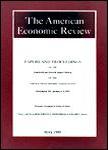-
作者:Engle, R
作者单位:New York University
-
作者:Guiso, L; Sapienza, P; Zingales, L
作者单位:Northwestern University; University of Chicago
摘要:To identify the effect of social capital on financial development, we exploit social capital differences within Italy. In high-social-capital areas, households are more likely to use checks, invest less in cash and more in stock, have higher access to institutional credit, and make less use of informal credit. The effect of social capital is stronger where legal enforcement is weaker and among less educated people. These results are not driven by omitted environmental variables, since we show ...
-
作者:Moretti, E
作者单位:University of California System; University of California Los Angeles; National Bureau of Economic Research
摘要:I assess the magnitude of human capital spillovers by estimating production functions using a unique firm-worker matched data set. Productivity of plants in cities that experience large increases in the share of college graduates rises more than the productivity of similar plants in cities that experience small increases in the share of college graduates. These productivity gains are offset by increased labor costs. Using three alternative measures of economic distance-input-output flows, tech...
-
作者:Javorcik, BS
作者单位:The World Bank
摘要:Many countries strive to attract foreign direct investment (FDI) hoping that knowledge brought by multinationals will spill over to domestic industries and increase their productivity. In contrast with earlier literature that failed to find positive intraindustry spillovers from FDI, this study focuses on effects operating across industries. The analysis, based on firm-level data from Lithuania, produces evidence consistent with positive productivity spillovers from FDI taking place through co...
-
作者:Çelen, B; Kariv, S
作者单位:Columbia University; University of California System; University of California Berkeley
摘要:This paper reports an experimental test of how individuals learn from the behavior of others. By using techniques only available in the laboratory, we elicit subjects' beliefs. This allows us to distinguish informational cascades from herd behavior. By adding a setup with continuous signal and discrete action, we enrich the ball-and-urn observational learning experiments paradigm of Lisa R. Anderson and Charles Holt (1997). We attempt to understand subjects' behavior by estimating a model that...


